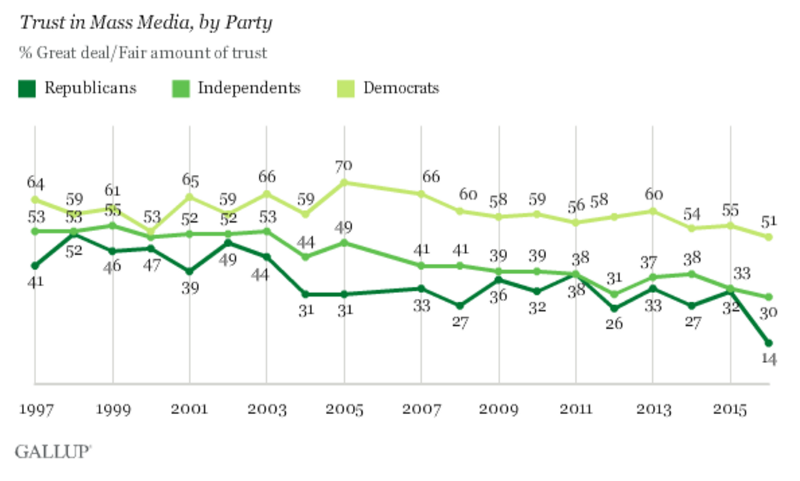I have written about this before, but it keeps coming up. So here I take a more detailed look at it. I show you ten versions of the same claim so you can gain a more rounded view of what I am talking about. After each one I comment. At the end I make some concluding points. (Or you can skip to my conclusions first, then read the analysis. Some readers recommend this.)
Date: Nov. 6, 2015
Headline: The Master of Manipulation
Jounalist: Mary Kate Cary, contributing editor, opinion section, US News and & World Report
When Trump insults war heroes, women, immigrants, his fellow candidates, Congress, members of the media – the list goes on and on – those are not one-off spontaneous outbursts where Trump is just popping off. Those are carefully planned “outrageous,” “sensational” stories used as bait to get the press to write about him – by his own admission. And it’s working. He’s become a master at manipulation.
My read: This is a very basic version of the claim in question. Trump says outrageous things that trigger eye-catching headlines (McCain got captured; what a doofus!) This is supposed to show he’s a “master” of media manipulation. Alternative view: it’s easy to generate headlines by being a colossal jerk in public. This takes no genius. It takes gall. And a press willing to amplify.
Date: January 5, 2016
Headline: Donald Trump’s free media bonanza
Journalist: Hadas Gold, media reporter at Politico
Donald Trump reserved nearly $2 million for a seven-day ad blitz in Iowa and New Hampshire this week. But the billionaire real-estate mogul and master media manipulator also got hundreds of thousands of dollars’ worth of free airtime on Monday — and even more in seemingly endless coverage and discussion of what amounts to a glorified press release touting his candidacy.
Trump’s new 30-second spot, released Monday morning, was played in its entirety 40 times on the cable news networks between Monday and Tuesday morning, according to POLITICO’s count. Using hour-by-hour prices provided by ad tracking firms for 30-second ads on CNN, Fox News and MSNBC, POLITICO estimated that the 40 airings would have cost Trump $330,000.
My read: Here the occasion for calling Trump a “master media manipulator” is that he got free advertising by releasing a nasty ad that was replayed and discussed as news. But any reporter familiar with political advertising knows that this in no way special to Trump. One of the most famous spots ever aired on behalf of a candidate, the “Daisy girl” ad intended to raise doubts about Barry Goldwater, ran exactly once. “And yet the ensuing media discussion — and re-airing of the ad on news broadcasts — gave the ad tremendous impact.” (Link.) “Consultants now know that attacks can draw significant attention in the free media, which gives them more incentive to produce and to air negative ads than they had 25 years ago,” wrote one political scientist in 2010. Ads have been covered as news for a long time. There is simply nothing here that is unusually masterful— or characteristic of Donald Trump.
Date: March 22, 2016
Headline: How Trump became a master of manipulating the media
Journalist: Emily Jane Fox, reporter for Vanity Fair.
Trump’s rise can best be explained as a successful marketing campaign. To voters, he has branded himself as the anti-politician politician. He says what some people want to say but feel they can’t. He wins, all the time, constantly; in fact, he is the most successful person to ever walk the earth. Despite multiple high-profile, ugly divorces, he has painted himself as the consummate family man.
The electorate slurps this all up…. By all accounts, Trump has the nation rapt and the media wrapped around his short fingers. But Trump has been successfully and self-servingly manipulating the press for decades, long before he entered the political arena. As The Washington Post reported Monday, for a decade starting in the 1980s, Trump sometimes assumed a fake name and pretended to be a spokesman representing himself when the media pressed him or he wanted to craft a deliberate message without connecting his name to it.
My read: The sentence, “Trump has the nation rapt and the media wrapped around his short fingers” is empty hype. It asserts; it does not attempt to convince. But here’s the tell: “The electorate slurps this all up.” That is an expression of contempt. Trump’s use of a fake persona shows you can fool reporters with fraud, but is that mastery? The internet has a name for the practice: sock puppetry. Practitioners of it are not normally seen as masters of anything. They are regarded as slightly pathetic.
Date: May 6, 2016
Headline: Trump a master media manipulator in his prime
Journalist: David Zurawick, media reporter and columnist, Baltimore Sun.
In August, I wrote a piece headlined, “TV may be too timid to cover Trump.” In it, I mapped some of the ways Trump was outsmarting and intimidating TV interviewers.
One of the people I interviewed was CNN’s Chris Cuomo who called Trump “The Great Deflector.” The morning-show host explained how Trump deftly deflected his questions about misogynistic comments.
“So, I ask him, ‘What about those things you said about women?'” Cuomo said. “And he says, ‘I’ll tell you who has real trouble with women: Jeb Bush.'”
And Trump was off and running, pivoting away from the question of misogyny to attack Bush.
My read: Trump is here said to be a wizard at media manipulation because he changes the subject. Deftly! As if a determined reporter could not change it back.
Date: January 12, 2017
Headline: As Trump Berates News Media, a New Strategy Is Needed to Cover Him
Journalist: Jim Rutenberg, media columnist, New York Times
There were two big lessons in the Wednesday morning melee.
1. Mr. Trump remains a master media manipulator who used his first news briefing since July to expertly delegitimize the news media and make it the story rather than the chaotic swirl of ethical questions that engulf his transition.
2. The news media remains an unwitting accomplice in its own diminishment as it fails to get a handle on how to cover this new and wholly unprecedented president.
My read: These two items are connected. One way for the press to avoid facing the “accomplice in its own diminishment” part is to testify about what a master of manipulation the guy is. If he’s awesomely great at it, then maybe being an accomplice isn’t so bad… We were tricked into participating by a master of trickery!
Date: January 11, 2017
Headline: Do Press Conferences Still Matter?
Journalist: Jeff Greenfield, writing in Politico Magazine.
To say that Trump does not have a traditional relationship with the press is a sure front-runner for Understatement of the Year… He gave more interviews to more media outlets than any other candidate—he was also far more in demand than any other candidate—and has spent countless hours on the phone with reporters, columnists and analysts. He has also shown himself to be a master of manipulation, using tweets as a symphony conductor uses his baton, all but compelling the press to cover his rant of the hour.
My read: Trump tweeted outrageous and politically risqué stuff. The press gave it crazy coverage because normally candidates are risk-averse. They’re afraid of earning high negatives. Masterful it would indeed be if Trump tweeted outrageous things and escaped high negatives. But of course he didn’t. Getting the press to cover you by saying shocking and irresponsible things does not seem that hard to me. I think I could do it. I think you could do it. The internet has a name for this practice: trolling. Everyone knows it can be effective. But it is not thought to be particularly difficult.
Date: January 17, 2017
Headline: Trump literally holds the world’s attention in the palm of his hand
Journalist: Abby Phillip, reporter, Washington Post
With Twitter, Trump — known as a master marketer in the real estate and entertainment world — has met his medium. Just as he stamps his buildings and properties around the world with his name, each Trump tweet is branded with his name and likeness and sends a clear signal to the political world about what he wants them to know.
Trump has thrown out the traditional social media handbook and replaced it with his own unmistakable flair. There are few hashtags or photos to catch the eye, only outrageous statements and exclamation marks. Trump rarely vets the content he retweets, largely ignoring established brands, preferring instead to amplify the voices of real people.
My read: Wanna know what a genius the man is at marketing his message? You’re not gonna believe this. “Each Trump tweet is branded with his name and likeness.” Amazing. And you know what else? He retweets random people who agree with him! Yes. But that’s not all. He doesn’t care if what they’re saying is true. No fact checking! Would you have thought of that? Admit it: you wouldn’t. Learn from the master, people.
Date: March 1, 2017
Headline: Trump Moves to Become Master of His Own Messages
Journalists: Maggie Haberman and Michael M. Grynbaum, reporters for the New York Times
All presidents lunch with major news anchors. But this week’s White House gathering was different. The president kept his guests 30 minutes beyond the allotted hour, was gracious and spoke so much that he left his peekytoe crab salad untouched — a recognition, those close to him say, that he must sell himself to the Washington news media because he believes the people who work for him cannot….
A master media manipulator and storyteller, Mr. Trump went without a traditional press secretary during the presidential campaign, preferring to field queries on his own. Now he is increasingly taking command of his administration’s message making, and privately expressing frustration with a White House press office under siege amid leaks and infighting.
My read: I don’t know how to evaluate this claim: “master media manipulator and storyteller.” It seems to refer to interactions between Trump and the newspaper reporters who interview him. These moments are normally unavailable to us. In a Twitter exchange about this very thing, Maggie Haberman advised me: “I’ve covered Trump periodically for 20 years. He is actually better at this aspect than traditional pols.” Better how? I do not know. When I told her I hadn’t seen the evidence of his mastery she replied: “Maybe your criticism should allow for things you don’t know first-hand.” Fair enough, Maggie! Dear readers: I have never interviewed Donald Trump. So I have not seen first hand his wizardry in manipulating reporters. Still: something makes me doubt the blinding brilliance of it. Maybe it’s the fact that he’s gotten more negative press than any candidate or president ever. Which leads us to…
Date: May 12, 2017
Headline: “The Subject Is the Proper Noun Donald Trump”
Journalist: Glenn Thrush, reporter, New York Times on WNYC’s On the Media
Context: Thrush was discussing an interview he and Maggie Haberman had done with Trump. It was supposed to be about infrastructure spending. Trump made an evidence-free accusation that Susan Rice broke the law “by seeking to learn the identities of Trump associates swept up in surveillance of foreign officials by United States spy agencies.” Glenn comments:
“We’re former tabloid reporters from New York. We went in with a very broadsheet mentality: to discuss infrastructure. He knows we’re tabloid folks. And he knows he can make news any time. I was annoyed personally by the fact that he chose to use the interview to kind of go off on Susan Rice. We had to report it… It was in the middle of a news cycle. We couldn’t have buried it, that’s not our function. That he why he is so effective. He understands the fact that we have a dual function: to break news, to get scoops, and to provide insight. We’d prefer to have those two halves of our being fused seamlessly together. Donald Trump — and this is his genius — understands how to cut us in half. He gets between us and our imperative. That is a very, very sophisticated thing that he does.”
My read: We’re supposed to believe it was effective, and an act of genius, for Trump to float an evidence-free charge against Susan Rice, and get Glenn and Maggie to feature it, when they had other ideas for the interview. But was it? A week later this is what CNN reported:
After a review of the same intelligence reports brought to light by House Intelligence Chairman Devin Nunes, both Republican and Democratic lawmakers and aides have so far found no evidence that Obama administration officials did anything unusual or illegal, multiple sources in both parties tell CNN.
Their private assessment contradicts President Donald Trump’s allegations that former Obama national security adviser Susan Rice broke the law by requesting the “unmasking” of US individuals’ identities. Trump had claimed the matter was a “massive story.”
Summing up: The New York Times reporters wanted him to talk about something positive he could do for the American people that was squarely on his governance agenda and has bipartisan support: infrastructure spending. But Trump cleverly diverted the conversation to a baseless charge about the previous administration that was soon shot down by his own party, after which the story sank. And the Times reporters were helpless, because the baseless charge was news. Genius!
Date: May 14, 2017.
Headline: Does Trump watch too much TV?
Journalist: Michael Scherer, reporter for Time on CNN’s Reliable Sources
“The president has always been an enormously sophisticated consumer of media. If you go back to the campaign, when he called Jeb Bush ‘low energy’ or Marco Rubio ‘little Marco,’ those were punditry moves. He was commenting on television, not on them as politicians, but on how they came across on television. And he still consumes his own presidency very much as a television show.” [Brian Stelter: when you went for your interview, he was watching TV with you, right?] “Not just was he watching it with us, we walked into the Oval Office, he said: ‘Come on, I want to show you something.’ He had queued it up for us, and he wanted to show it to us, and he wanted to do color commentary, which was actually rather vicious.”
My read: “The President can watch himself on TV and play pundit at the same time. I know that sounds impossible, but he gave us a live demo. In the White House. It’s real, folks. And let me tell you: the man is a champion television watcher. He’s incredible at it. Enormously sophisticated…”
Conclusion: To the claim that Trump is a master of media manipulation — which I doubt — I offer these alternatives:
1.) He cannot be shamed. Trump does not care if he is shown to be a liar, idiot, ignoramus, clown, or monster. Most people are not built like that. Therefore he can generate media attention without caring about the consequences. Most people are not built like that, either.
Trump is exceptional, but this is different from saying he is a masterful. In fact, he’s a compulsive. Which is the opposite of mastery. Everything explained by attributing to Trump some genius for the media arts is better explained by his utter shamelessness, his malignant narcissism— and his indifference to being the clown figure.
2.) He is risk-friendly in a field where nearly all practitioners are risk-averse. This follows from what I just said. Enormously risky behavior is routine for Donald Trump, because he simply doesn’t care if he is shown to be a liar, idiot, ignoramus, clown, or ethical monster. Therefore he can accuse a previous President of the United States of a devilish crime without any evidence… and feel fine about it. It’s true that by these methods he dominates the news agenda and forces attention to his groundless charges, but “master media manipulator” is a poor description of the man who would do that.
3.) If you have opened yourself to manipulation, it’s less bad if a master of it did this to you. Think about it. If it takes a wizard to manipulate me, I must be pretty smart… right? When journalists testify to Trump’s genius as a mover of media they are bragging in a way they don’t quite realize. For they are implicitly saying: genius is required to manipulate us. Sorry, it’s not. Anyone in a position of power willing to float a false accusation can get you to cover it— and subvert your intention to cover something else. Anyone eager to make a spectacle of himself can create lurid headlines. Anyone smashing to bits norms of democratic governance will dominate the news agenda.
If you are a man, and you bite a dog, that does not make you a master of anything. But it does make of you news.


